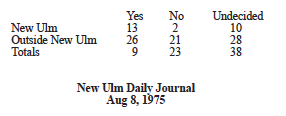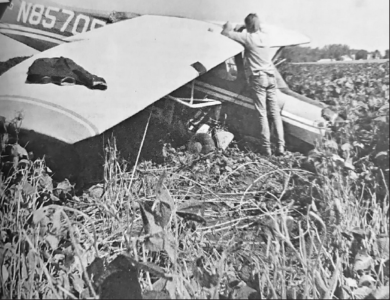1 STOCKHOLDER AND 125 PATRONS AIDING CREAMERY
Farmers Organize
In 1895 To Promote Co-Operative
Concern.
——–
FRED DEHN
MANAGER FOR
PAST 14 YEARS
——–
Pay Patrons
Approximately $150,000 For
Cream Used
Last Year.
——–
In describing the oldest creamery in this vicinity, enough cannot be said of the present efficient management. However, since this Co-operative Farmers concern, established here in 1895, moved to their new modern creamery, located at the corner of Broadway and Third North street, the volume of business for the years since 1920, has been increased once again, and is steadily growing.
The old creamery operated by this firm was located at the foot of the College hill on Center Street. This building has since been made over into a residence by a Mr. Redecker, who moved here from California and who has made it a most attractive living place.
In February, 1920, the present location of the Farmers Creamery was ready for occupancy, and possession was taken at this time. At a cost of $30,000 the building and equipment was prepared for the fast growing business. Fred W. Dehn who has been the butter-maker for this corporation since 1910, has full charge, acting as manager and Carl Vetter is his assistant. Mr. Dehn is a very competent man, and fills his position with entire satisfaction to the officers and stockholders.
Story Of Butter Making.
Story Of Butter Making. The process, and the equipment used in the making of the chief product of the creamery, golden butter, is most interesting to the person seeking information. When the cream is taken from the cans which the farmers use to bring it to town in, it is taken to a scale, where it is weighed sampled and graded. The cream is then turned into a ripener, a huge barrel-like receptacle. A huge coil, thru which hot water passes, revolves in the ripener, and in this manner the cream is pasteurized by heating to 160 degrees. The water in the coil is then replaced with cold water and the cream is cooled. From here the cream is poured into the two large one thousand pound churns, with paddles’ arranged the full length of each. The butter is made by whipping the cream with these paddles. As soon as the butter has gathered the buttermilk is drained off and cold water is run into the churns, so that the butter may be washed. Following this procedure the salting is done. More than 9,000 pounds of salt is used each year by this creamery, and in the busiest season, summer, between nine and ten thousand pounds of butter is manufactured each month. After the salting, the butter is packed in 64 pound tubs, and placed in the large refrigerator, preparatory to shipping.
After remaining in the refrigerator which is cooled by their own cooling system, the tubs are labeled and shipped to various points. All the surplus tub packed butter is at present shipped to Cleveland, Ohio. The pound prints are sold to local merchants, local patrons and consumers, and much of this butter is shipped to Iowa points and Minnesota Cities.
Churning takes place three or four days out of each week. The butter is handled with long wooden spades, which are efficiently wielded by the butter-makers.
Butter, cream and butter milk is retailed. More than $150,000 was paid out to cream patrons in 1923.The year’s volume of business ran to more than $166,000.
The New Building.
Illinois red brick and Bedford White Stone was used in the construction of the new building which is 56×60 feet, and has been most conveniently arranged to save time and footsteps in the making of butter. On the first floor space is given to a neatly arranged office, which has just recently been redecorated in light tan and brown shades. A colored border has been stenciled on the walls and finishes them in a pleasing manner. The ladies rest room is complete in its furnishings and affords a quiet place for relaxation for tired shoppers. The floors thru out the building are made of cement. This feature is of course essential in the creamery department. Here the walls are painted white and are kept spotless at all times. Two large churns, pasteurizing devices, and other necessary utensils are kept here for use in the work. An elevator room is built to the back of this department and is used to carry tubs and other supplies to and from the large store room arranged on the second floor upstairs. The elevator is operated by water pressure. A small store room aids in the work. A large refrigerator is located on the first floor and there is ample room for caring for the entire production of the creamery. The second floor is finished in a plain ‘manner, with tile walls and cement floors. Milk cans, surplus machinery and other articles needing storage are placed here.
Efficient Management.
Fred W. Dehn, butter-maker, is rated among the leading men in the state in his profession. He has been awarded many diplomas for his high test butter entered in contests all over the state. Last year at the state fair he entered butter in the scoring con-test and received a diploma from the Minnesota State Agricultural Society for the excellence of creamery butter exhibited at the state fair held at Hamline, September 1-8, 1923, with a score of 94 per cent.
Officers And Directors.
Officers in charge of the company this year, are: President, John Poehler; Vice-President,- Andrew Portner; Secretary, J. M. Haubrich; Treasurer,P. P. Manderfeld; Directors: Fred Wellner, Frank Forster, and John Seifert. 81 stockholders have incorporated the Farmers Co-Operative Creamery and with the 125 patrons, are doing their share towards making New Ulm a trading center. With each year the business increases and it is necessary to have a helper in the busiest time. With the splendid lo-cation, present good management, and the support given this concern, the future looks bright.
New Ulm Review,
March 26, 1924
————————


